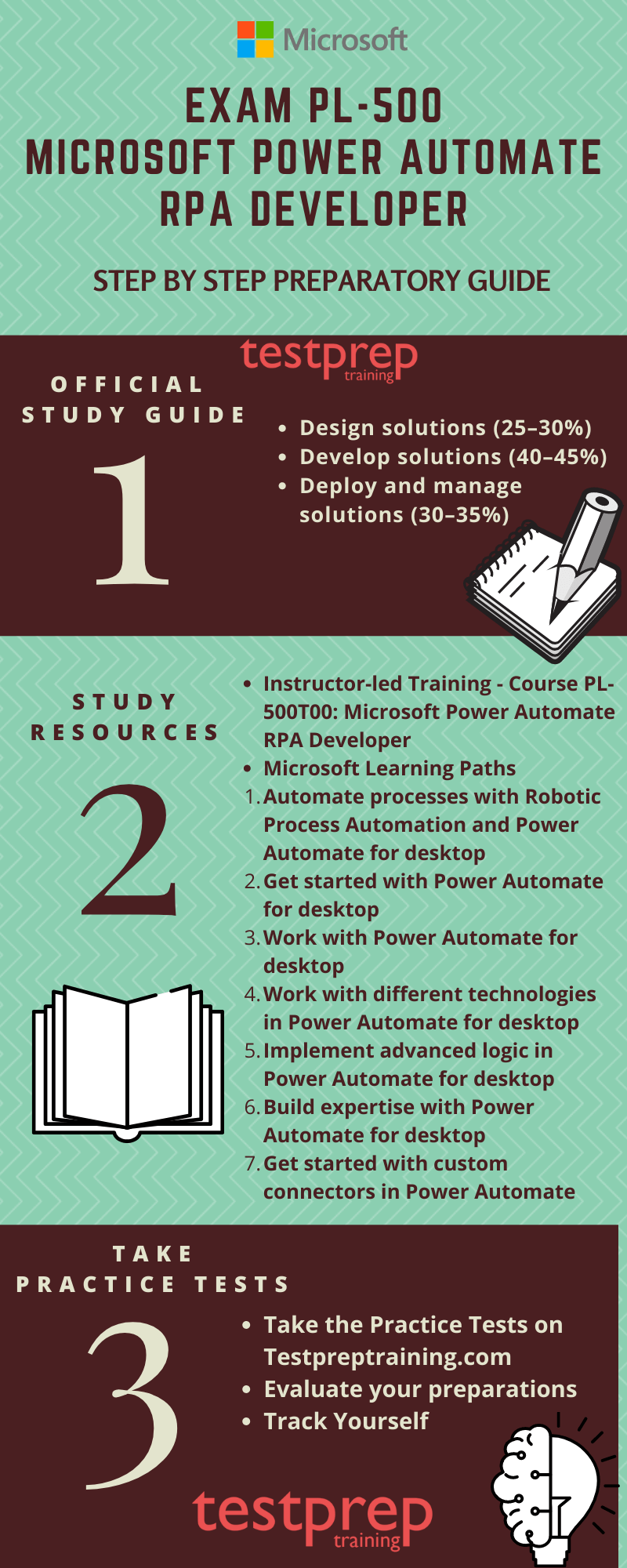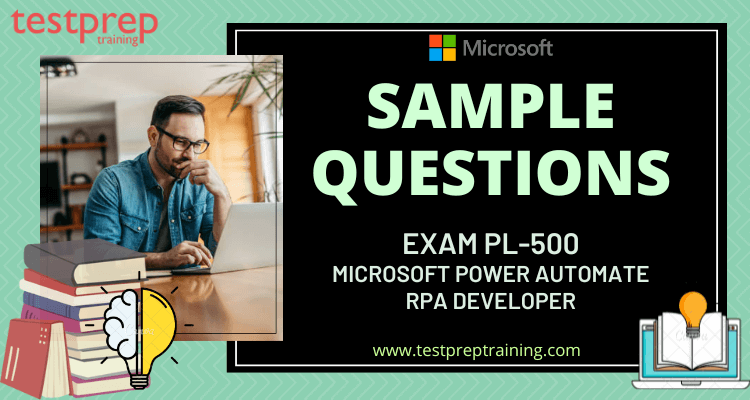Exam PL-500: Microsoft Power Automate RPA Developer

The Exam PL-500: Microsoft Power Automate RPA Developer assesses your technical abilities in designing, developing, deploying, and managing solutions. The exam requires candidates to automate repetitive and time-consuming tasks using Microsoft Power Automate. Their responsibilities include reviewing solution requirements, creating process documentation, designing, developing, troubleshooting, and evaluating solutions. As part of their training, candidates will improve and automate business workflows in collaboration with business stakeholders. Specifically, they support solutions and collaborate with administrators to deploy them.
Exam Details
| Exam Name Exam PL-500: Microsoft Power Automate RPA Developer | Exam Code PL-500 |
| Exam Language English, Japanese, Spanish, German, Chinese (Simplified), French, Korean | Exam Fee $165 USD |
Schedule Your Exam
Follow the steps below to schedule your Microsoft certification exam –
- Go to the Microsoft portal, to register yourself
- Click on “Schedule Exam” to schedule an exam date at your convenience
- Fill in all your details asked on the next page that appears
- Select the exam delivery option on the Pearson VUE page
- Pay your exam fees. You have successfully registered for the PL-500 Exam
Microsoft (PL-500): Power Automate RPA Developer Sample Questions
Exam Retake Policy
If anyhow you are not able to achieve a passing score in the Microsoft PL-500 exam. However, you will have to wait for a minimum of 24 hours before you become eligible for a retake. Failure in the second attempt will result in a waiting time of 14 days before rescheduling your third attempt. The waiting period for the fourth and fifth attempts will also be 14 days. All candidates are allowed a maximum of five attempts per year.
Exam Cancellation Policy
Microsoft offers the candidates to cancel or reschedule their exams within a minimum of 24 hours prior to the exam date. However, to prevent any cancellation fee, you must cancel or reschedule your exam, at least 6 business days prior to the date scheduled for your exam. Also, if you fail to appear in the exam, you will not receive any refund of the fee.
Recertification Policy
Microsoft certification is expected to expire when the products are out of mainstream support although the person’s certificate will be recognized.
Exam Result
Right after successfully completing your Exam PL-500, you will be notified of your pass or fail status within a few minutes of completing your exam. Also, printed reports providing your exam score and feedback on your performance will also be provided to you. Your score will be forwarded to Microsoft within five business days.
For more details see: Exam PL-500: Microsoft Power Automate RPA Developer FAQ
Course Outline – Exam PL-500: Microsoft Power Automate RPA Developer
The Exam PL-500: Microsoft Power Automate RPA Developer covers the following domains:
Design automations (30–35%)
Describe Power Automate features and capabilities
- Identify the Power Automate ecosystem and offerings
- Identify the differences among cloud flows, and desktop flows, and business process flows
- Identify when to use a desktop flow or a cloud flow, and when to use them together
- Identify the different trigger types for cloud flows
- Identify options for interacting with target applications and browsers
- Identify the different methods for running a desktop flow
- Identify considerations for running cloud and desktop flows concurrently
- Identify considerations for running desktop flows attended versus unattended
- Differentiate HTTP actions in cloud and desktop flows
Work with other Microsoft Power Platform offerings
- Identify how canvas apps and model-driven apps work with automation
- Identify use cases for connectors, custom connectors, connection references, and connections for cloud flows
- Identify use cases for Microsoft Dataverse
Record and analyze processes
- Create processes in Process Advisor
- Identify the steps for Process mining
- Identify the steps for Task mining
- Identify the use cases for Process Advisor
Identify how to analyze and enhance data and documents
- Identify Microsoft AI options for processing documents in desktop and cloud flows
- Identify Microsoft AI options for processing data in desktop and cloud flows
- Identify optical character recognition (OCR) capabilities in desktop flows
- Identify use cases for the Document Automation Toolkit
Identify use cases for scripting languages in desktop flows
- Identify use cases for scripting languages including PowerShell and VBScript
- Identify use cases for application-specific macro languages including VBA in Microsoft Excel and Office Scripts
- Identify use cases for using JavaScript
- Identify how to use the document object model (DOM) in automation
Develop automations (40–45%)
Create and manage cloud flows
- Create a cloud flow
- Create a cloud flow that calls a desktop flow
- Create and use child cloud flows including how to pass data to a child cloud flow and return data back
- Perform actions in cloud flows by calling external APIs
- Configure filter conditions and concurrency in cloud flows
- Configure timeout and retry policies in cloud flows
- Implement data objects in cloud flows
- Identify common processes for parsing text including JSON, XML, and CSV in cloud flows
- Configure cloud flow action to run Microsoft Office Scripts
Create and manage desktop flows
- Create desktop flows to launch, connect to, and authenticate target application
- Configure user interface (UI) options
- Configure datatables, lists, and custom objects in desktop flows
- Implement subflows in desktop flows
- Add desktop actions to exit from target applications
- Perform actions in desktop flows by calling external APIs
- Configure timeout and retry in desktop flows
- Implement data objects in desktop flows
- Identify common processes for parsing text including JSON, XML, and CSV in desktop flows
Implement logic in cloud and desktop flows
- Configure flow control in cloud and desktop flows including loops
- Configure expressions in cloud flows
- Configure variable actions for cloud and desktop flows
- Configure secure input and output data in actions in cloud flows
- Configure secure variables in desktop flows
- Configure priority for desktop flows in a queue
- Create exception handling blocks in cloud and desktop flows to handle system exceptions
- Create error handling routines in cloud and desktop flows to handle business exceptions
- Configure document processing by using AI Builder
Create and configure custom connectors
- Create a custom connector
- Implement authentication for custom connectors
- Identify custom connector policy templates
- Write code in a custom connector
Manage automation infrastructure
- Configure credential management
- Connect cloud flows to on-premises data by using the on-premises data gateway
- Create and manage components in Microsoft Dataverse solutions
Test automations and finalize development efforts
- Run and test a cloud flow
- Run and test a desktop flow
- Manage configurations by using environment variables and configuration files
- Debug solutions by using Power Automate cloud and desktop flows debugging features
Deploy and manage automations (20–25%)
Prepare target environments
- Implement Microsoft Power Platform application lifecycle management (ALM)
- Differentiate credentials used for different environments
- Deploy RPA solutions to other environments
- Prepare virtual desktop environments for unattended desktop flow execution
Evaluate data loss prevention (DLP) policies for RPA execution
- Identify Microsoft Power Platform data loss prevention (DLP) policies
- Identify how DLP policies impact actions in cloud and desktop flows
- Identify how DLP policies apply to custom connectors
Manage access to RPA components
- Share a cloud flow
- Share a desktop flow
- Share machines and machine groups
- Identify security roles required to run and monitor cloud and desktop flows
- Create service accounts and service principals
Configure machine groups and queues required for desktop flow automations
- Identify use cases for and capabilities of machines and machine groups
- Manage machine registrations
- Create and manage machine groups
- Implement load balancing of desktop flows by using machine groups and queues
- Work with queues and queue operations for desktop flows
- Evaluate cloud and desktop flow run history from the Power Automate portal
Preparation Guide for Exam PL-500: Microsoft Power Automate RPA Developer

Get Familiar with the Exam Objectives
The course outline is a good resource to review prior to the exam. It is important to manage your time effectively, determine what needs to be done, and how to accomplish it. Further, you should regularly check the official website to stay updated on any course changes. In Exam PL-500, the following topics are covered:
- Design solutions (25–30%)
- Develop solutions (40–45%)
- Deploy and manage solutions (30–35%)
Instructor-led Training – Course PL-500T00: Microsoft Power Automate RPA Developer
The aim of this training is your help you develop the following skills:
- Designing RPA solutions
- Developing RPA solutions
- Deploying and managing RPA solutions
Microsoft Learning Paths
Microsoft Learning Paths offer dynamic and interactive online experiences that will help you accomplish your technical and professional goals faster. Microsoft Learn allows you to track progress, assess knowledge, and validate deployments to earn points, levels, achievements, and trophies. A series of bite-sized modules provide you with an understanding of the topic chosen. The Learning Paths for the Microsoft Exam MB-500 exam are as follows:
- Automate processes with Robotic Process Automation and Power Automate for desktop
- Get started with Power Automate for desktop
- Work with Power Automate for desktop
- Work with different technologies in Power Automate for desktop
- Implement advanced logic in Power Automate for desktop
- Build expertise with Power Automate for desktop
- Get started with custom connectors in Power Automate
- Configure custom connectors with authenticated APIs in Power Automate
- Introduction to Microsoft Power Platform security and governance
Microsoft Press Books
The reference books provided by Microsoft Press Store can help you prepare for the exam more efficiently. These books contain a variety of useful resources you can use during your study process. You will gain a deeper understanding of the exam objectives by reading Microsoft Press books.
Join Microsoft Community/ Online Forum
Getting more people involved in an issue increases its chances of resolution. Discussions of diverse viewpoints also enhance the quality of the content. Studies can become more comprehensive as a result of these discussions. Our participation in forums builds a sense of community, and we gain a deeper understanding of one another.
Practice Tests
Regardless of how you prepare for Exam PL-500: Microsoft Power Automate RPA Developer, you will benefit greatly from practicing. Your real test results will be better if you diversify your study strategy with practice tests. Analyzing your answers can also help you determine whether they align with the exam objectives.



